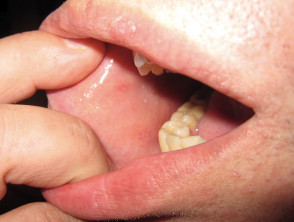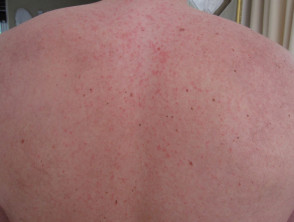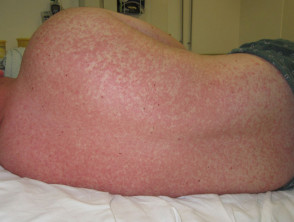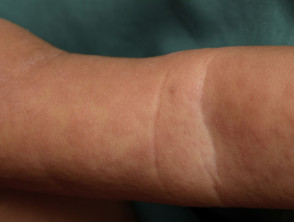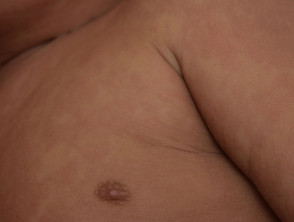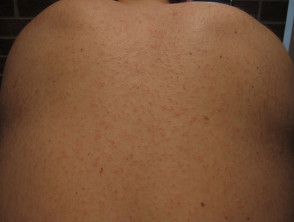What is measles?
Do you have confirmed measles? Send DermNet your pictures.
Measles, also known as English measles, rubeola or morbilli, is a highly contagious viral infection causing fever and a rash.
Measles is a notifiable disease.
Measles
What is the cause of measles?
Measles is caused by the measles virus, which belongs to the morbillivirus family.
How common is measles?
Before widespread immunisation against measles in industrialised countries, measles was a very common childhood disease that carried a high death rate. Nowadays in countries where measles is part of an immunisation programme, the risk of exposure and incidence of actual disease cases is low. A recent trend by some parents not to immunise their children has led to an increase in the number of cases of measles, and its complications.
In developing countries, measles still occurs frequently and is associated with a high rate of complications and death. It remains a common disease even in some developed countries of Europe and Asia.
WHO reported a surge in cases worldwide in 2018, with nearly 10 million cases, and more than 140,000 deaths mostly in children under 5 years of age. The highest incidence rates were in the Ukraine, Somalia, Democratic Republic of Congo, Liberia and Madagascar. The US reported its highest rate of infection in 25 years, and four countries in Europe lost their 'measles elimination' status.
How do you get measles?
Measles is highly contagious and is easily spread from person to person by breathing in airborne respiratory droplets from an infected person's coughing or sneezing.
An infected person is contagious 2 days before any symptoms show, and remains infectious for at least 5 days after the onset of rash.
An acute infection of measles almost always gives lifelong immunity.
Who is at risk of measles?
Individuals at particular risk of measles infection include:
- Infants who have lost their passive immunity from their mothers (acquired from their mother through the transfer of antibody across the placenta) and before their first immunisation
- Unvaccinated travellers to areas where measles is endemic
- Individuals with immunodeficiency (eg, due to infection with HIV/AIDS, leukaemia, cancer, corticosteroid therapy), regardless of their immunisation status
- Migrants and refugees.
The greatest risk for severe measles and its complications is seen in:
- Malnourished individuals (particularly children who are deficient in vitamin A)
- Those with an underlying immune deficiency
- Pregnant women.
What are the signs and symptoms of measles?
Measles develops through distinct clinical stages.
Incubation period
- Ranges from 7–14 days (average 10–11 days).
- The patient usually has no symptoms.
- Some may experience symptoms of primary viral spread (fever, spotty rash, and respiratory symptoms due to virus in the bloodstream) within 2–3 days of exposure.
Prodrome
- Generally begins 10–12 days after exposure.
- Presents as fever, malaise, and loss of appetite, followed by conjunctivitis (red eyes), cough, and coryza (blocked or runny nose).
- 2–3 days into the prodromal phase, Koplik spots appear. These are blue-white spots on the inside of the mouth opposite the molars, and occur 24–48 hours before the exanthem (rash) stage.
- Prodromal symptoms usually last for 2–5 days but in some cases may persist for as long as 7–10 days.
Exanthem (rash)
- Flat red spots ranging from 0.1–1.0cm in diameter appear on the 4th or 5th day following the start of symptoms.
- This non-itchy rash begins on the face and behind the ears. Within 24–36 hours it spreads over the entire trunk and extremities (palms and soles rarely involved).
- The spots may join together, especially in areas of the face.
- The onset of the rash usually coincides with a high fever of at least 40C.
- The rash begins to fade 3–4 days after it first appears. It fades first to a purplish hue and then to brown/coppery coloured lesions with fine scales.
Recovery
- A cough may persist for 1–3 weeks.
- Measles-associated complications may be the cause of persisting fever beyond the 3rd day of the rash.
Measles exanthem
How is measles diagnosed?
Diagnosis of measles is based on the characteristic history and physical examination. Because the disease is now so rarely seen in developed countries, any suspected cases require laboratory confirmation. This is particularly useful in the following situations:
- Sporadic cases
- Atypical cases
- Confusion with other diseases.
Acute measles is usually confirmed on a viral nasopharyngeal or throat swab analysed by polymerase chain reaction (PCR). Blood and urine samples can also be used. This should be done within 5 days of onset of rash, however, positive results are sometimes obtained up to 10–14 days after the rash has resolved.
Blood is also taken for measles IgM and IgG antibodies (serology). Levels of specific IgM become elevated during the active infection phase and IgG antibody appears during the recovery phase.
Viral culture of the throat and nasopharyngeal swabs is preferred in immunocompromised patients where serological evidence might be absent due to decreased immune response. An immunofluorescence test for measles antigen can also be considered in patients with poor immunity.
What is the treatment of measles?
There is no specific treatment for measles, which is why immunisation is so important. Treatment for mild cases of measles is supportive. Bed rest is vital, as it prevents complications and prevents the spread of the virus.
- Give paracetamol for fever. Aspirin should not be given to a child with a viral illness, as it is associated with the development of Reyes syndrome.
- Vitamin A for children in developing countries or that are malnourished. WHO recommends a dose of 200,000 international units (IU) of vitamin A for two days, for reducing measles and its complications. A Cochrane Review found this reduced mortality and pneumonia-related mortality in children under the age of 2 years.
- Maintain adequate fluid intake to prevent dehydration.
- Use a humidifier to provide relief from cough/sore throat.
- Provide nutritional support as necessary.
- Observe high-risk individuals carefully to prevent complications.
Patients with drowsiness, dehydration, or discomfort breathing require hospitalisation for supportive care.
Antibiotics are only needed to treat secondary bacterial infections such as otitis media, infectious diarrhoea, pneumonia, and sepsis.
Ribavirin (antiviral) is used to treat measles infection in immunocompromised patients and in those affected with subacute sclerosing panencephalitis.
What are the complications from measles?
Approximately 30% of reported measles cases have one or more complications.
- Gastrointestinal: diarrhoea that may be fatal if dehydration occurs, mouth ulceration, appendicitis, hepatitis, mesenteric adenitis, and pancreatitis.
- Ears: otitis media (almost exclusively in children) may lead to deafness.
- Respiratory tract: laryngobronchitis, measles croup, and pneumonia (either primary viral or secondary bacterial) — the most common cause of death from measles.
- Heart: myocarditis and pericarditis.
- Haematological system: thrombocytopenia, causing bleeding and disseminated intravascular coagulation (DIC).
- Eyes: conjunctivitis and/or corneal ulceration leading to blindness (especially if vitamin A deficient), and squint.
- Kidneys: acute glomerulonephritis (inflammation of kidneys) and renal failure.
- Nervous system: febrile seizures and encephalitis.
- Malnutrition (especially if from a poor community).
- Measles infection during pregnancy increases the risk of premature labour and delivery, fetal loss and maternal death.
Rarely, subacute sclerosing panencephalitis—a fatal condition—develops decades after a measles infection due to persistence of the measles virus in the central nervous system.
How can measles be prevented?
Measles can be prevented by vaccination with live attenuated measles vaccine. It is available as a single antigen preparation or combined with live attenuated mumps and/or rubella vaccines. Combined measles, mumps and rubella (MMR) vaccine is currently part of routine immunisation programmes in most industrialised countries, including New Zealand.
Measles vaccine induces long-term (probably life-long) immunity in most individuals. Vaccination schedules recommend a two-dose immunisation strategy; the first dose at 12–15 months of age, followed by a second dose at 4–6 years.
Measles vaccine should not be given during pregnancy. Women not previously immunised against measles should avoid pregnancy for one month (28 days) after receiving the MMR vaccine.
Immune globulin does not prevent measles, but it is helpful in decreasing the severity of illness in those exposed to the virus. It is recommended for:
- Pregnant women
- People with immune deficiency
- Infants.
Individuals vaccinated prior to 1968 may require revaccination, as vaccines used before this time may not have conferred life-long immunity.
